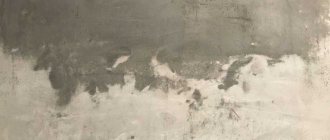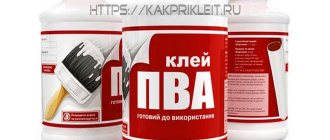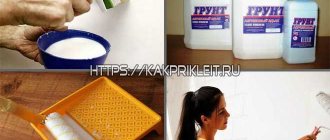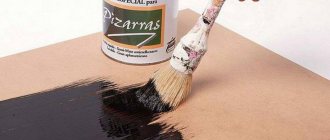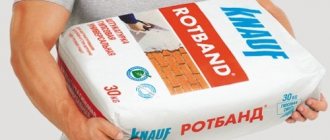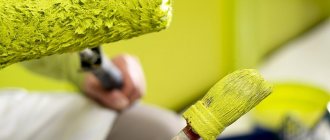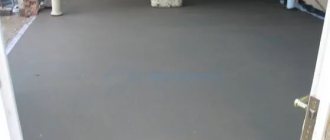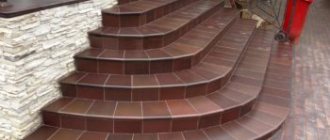Aerosol varnishing and painting compositions for metal surfaces are used in the repair and decoration of household appliances, roofing elements, furniture fittings, and doors. They are widely in demand in interior design. But to obtain a high-quality coating, you need to take into account the time it takes for the spray paint to dry on the metal.
How long should paint on a car dry and when can you start washing the car?
Have you thought about painting the car body or its individual parts yourself? Then you will definitely have standard questions that many car enthusiasts ask, and in this article we will try to answer them.
How long does it take to dry a car after painting?
As you yourself understand, this time interval directly depends on many factors. Firstly, this is the temperature regime, which must be maintained at +18 - +22 degrees Celsius. Secondly, it is the type of paint itself. Acrylic enamel and nitro enamel dry quickly enough, and after just a few days you can operate the car. Other types of paints and varnishes require a longer drying period. Thirdly, this is the use of additional equipment in the form of air-heated convectors or IR heaters, which can significantly speed up the paint polymerization process, and you will gain in terms of the time it takes such a coating to dry.
Let's look at the approximate time intervals that you will need to carry out the work. If you paint in a garage, the varnish and paint will set in 6–7 hours when using a spray booth or IR panels, and about 1–2 days simply by maintaining the temperature in a ventilated garage. But determining exactly how long the paint on a car dries is quite difficult even for an experienced master. Usually they choose time with a margin so that the car can sit and the paintwork gains the required level of strength, and this is a period of about a week.
https://youtube.com/watch?v=BnVTQGeOnlA
How long after painting a car can you drive?
It all depends not only on the type of material, but also on the operating conditions. If you drive carefully, without getting caught in the rain or driving into mud, then after 2–3 days you can use your car. The best option would be to let the car sit for about 14 - 20 days, but not every car enthusiast is ready to leave their vehicle for such a period of time. Such a long term is obtained due to the fact that in addition to the paint itself (base), you also cover the car body with varnish, which also takes a long time to dry. First of all, the varnish dries, and then there is a gradual crystallization and drying of the base itself.
How long after painting can you wash your car?
Experienced professionals advise not to wash your car for a month, especially avoiding high-pressure washing. This is due to the slow polymerization of the paint under the varnish, and using mechanical force can damage the coating. The minimum period of time after which you can start a car is 15 days. After this period, you can use auto chemicals.
Here are some tips for washing your car after painting.
- For the first 15 to 30 days, do not use chemicals to wash your car.
- Do not use a high pressure washer.
- It is better to wash with soft rags or washcloths, and never use hard brushes.
Of course, there are cases when car enthusiasts wash their vehicle at a car wash within a few days. But the question is, are you ready to risk your money? If not, then it's better to wait.
Scope of application
Due to the wide range of types and universal properties, alkyd enamels are widely used in repairs and construction for painting almost any material. Such coatings can be used for interior and exterior repair work. Alkyd enamels are most often used for painting structures made of metal, wood and concrete. Alkyd-urethane paint for metal structures reliably protects the surface from the influence of negative environmental factors and prevents the formation of rust.
It can be used for painting industrial structures and household objects, for example, heating radiators.
A special alkyd enamel is produced for machine parts. This paint is made on the basis of glyphthalic resins. Alkyd enamel can also be used to coat the body of a vehicle. The automotive mixture is applied in three layers, which increases its complete drying time. The resulting coating is highly durable and resistant to cracking.
Paint based on pentaphthalic resins is ideal for painting floors and walls, as it has excellent resistance to abrasion and mechanical stress. This composition is also widely used for processing metal structures for various purposes.
Types and properties
Alkyd enamels are classified by composition. Each type of coating has its own characteristics and technical characteristics. Special purpose paints are also available for certain types of surfaces. Each type of alkyd enamel has a special marking consisting of numbers and letters. Labeling allows you to accurately determine which category a particular composition belongs to. The letters indicate the main component that was used in the manufacture of the material:
- GF – enamels based on glyphthalic varnish;
- PF – enamels based on pentaphthalic varnish;
- ML – melamine alkyd compositions;
- MS – alkyd-styrene mixtures.
The first digit after the letter abbreviation plays the role of an identifier of certain properties and the purpose of the composition. It is worth considering the meaning of each number:
- 1 – this solution can be used for construction work outdoors;
- 2 – this composition is intended for repair work inside buildings. In this case, the absence of heating in the room is allowed;
- 3 – enamels are used only as temporary protection (preservation) of various surfaces;
- 4 – this category of alkyd paints and varnishes has a high level of moisture resistance;
- 5 – enamels, which contain special components, thanks to which the paint has a special purpose. For example, the mixture may repel rodents or have a luminescent effect;
- 6 – mixtures are highly resistant to various petroleum products;
- 7 – enamels that have excellent resistance to aggressive chemicals;
- 8 – such solutions are highly resistant to high temperatures;
- 9 – compositions with electrical insulating properties. Such enamels perfectly withstand electrical stress and current;
- 0 – the mixture is intended for priming various surfaces.
The last two digits in the marking indicate the location of the enamel in the general catalog. Alkyd compositions are also divided according to the form of release. Enamel can be purchased in liquid form in cans or as a spray in aerosol cans. As an example, it is worth considering the most popular alkyd compositions.
- PF-115. This composition can be freely used indoors and outdoors. Enamel is used for painting metal and wood structures, as well as for cement, gypsum and concrete bases. The coating is applied in no more than two layers. The composition dries completely within a day after painting.
- PF-133. This modification of alkyd enamel is perfect for application to metal surfaces. Painting has a long service life, which can be 6 years. At the same time, the technical characteristics and appearance of the coating do not change. Quick-drying enamel PF-133 is applied to the surface in at least two layers. This coating takes about two hours to dry.
- PF-233. The composition is used for painting metal and wood. The mixture is ideal for painting heating radiators, while PF-233 enamel has excellent covering properties; it can even be applied over a layer of old paint. The paint and varnish material has good resistance to high temperatures. The drying speed of the coating is slightly slower than that of other alkyd compositions. Complete drying time can reach 36 hours.
- PF-253. This paint and varnish composition is intended for painting heating radiators and wooden floors. Before applying enamel to the floor covering, the wood must first be primed. After the composition dries, a smooth and glossy coating is formed on the surface.
- GF-230. This enamel is designed for indoor renovation work. There are some limitations in the use of this composition: the paint is not suitable for floors, as it is sensitive to large mechanical loads. To dilute the mixture, you can use white spirit or turpentine. Before complete drying, the coating has a rather pungent odor.
Material consumption per 1 square meter
Spray consumption is about 200-300 milliliters per 1 square meter. But this parameter is influenced by many factors. These include the following:
- Quality of material. The composition of the paint affects the quality of application. Therefore, it is important to buy sprays from trusted manufacturers.
- Paint color. The lighter the aerosol, the higher its consumption. To obtain a uniform shade, you will have to apply many layers.
- Surface shade. The darker the plastic, the more layers of paint you need to apply to change the shade. This is especially true when repainting dark surfaces into light ones.
- Absorbent characteristics of the material. The consumption of the substance is directly affected by the structure of the plastic. Surfaces that have a high absorption capacity absorb aerosol quite strongly. Therefore, for a high-quality coating, more paint will be required.
How long does acrylic paint take to dry?
The contours are applied directly from the tube with light pressure. The pasty mass forms a relief line. The thickness of the line is adjustable: if you tighten the compression of the tube and move it along the fabric slowly, the line will be thicker.
Fixing paints with an iron The finished product is ironed with an electric iron with a thermostat, at a temperature characteristic of the fabric used. The product is ironed from the wrong side. Today there is an opportunity to quickly learn how to decorate fabric. Everyone can try themselves in creativity. Invent, decorate, make things unique.
About Coating
How many layers of varnish need to be applied to a car depends on the chosen material, this has already been discussed, so let’s look at the application process itself. The painting process should begin with the ends and various recesses of the body, then move on to the main surfaces
It is important to choose the right spray gun nozzle; for “wet” use it should have a size of no more than 1.5 mm. The application process depends on the area of the surface to be painted.
In the case where a large surface of the car body is being painted, the varnish is applied with a cross-shaped movement of the spray gun. If the surface has a small area, the varnish is applied by rotating in a spiral. They start moving from the outside of the surface to be painted and gradually move towards the center. The distance of the spray gun from the surface should be no more than 25 cm; if this distance is reduced, you can get sagging, smudges, and other defects.
It is also important to know how long it takes to apply varnish after painting a car, it depends on the material used. Drying of the coating is carried out according to the previously indicated recommendations; you should also carefully read the instructions for use of the material used
It is highly undesirable to use a fan for drying, as it can attract dust onto the painted surface. It is best to use reflector lamps.
It is impossible to talk about absolutely all the nuances of applying a layer of varnish to a car body in a short article. For a more in-depth look, watch this video:
Varieties and recommendations for selection
Aerosol dyes have different types:
- Polymer – combine the functions of primer and paint. Such substances are characterized by a high degree of adhesion. They do not require prior application of a primer layer.
- Resistant to damage - highly durable. The composition of such products includes polyurethane components and acrylates. They are used for application to surfaces that are subject to severe mechanical stress.
- Structural - after drying, they form a beautiful surface with slight roughness. This makes it possible to hide defects that appear on the plastic. The use of structural materials helps to achieve an unusual decorative effect.
- Soft touch – this dye gives a velvety surface. Objects coated with this enamel give a feeling of softness and comfort.
- Monad - used for PVC plastic. They have a high degree of adhesion and are characterized by resistance to ultraviolet radiation.
A large number of substances for coloring plastic allows you to choose the best option that suits a specific type of surface. The following criteria should be taken into account:
- Consistency with the basis. The instructions usually contain information regarding the type of plastic that can be treated with a particular product.
- Appearance of the painted surface. When choosing a material, you should take into account your preferences and the desired result. The moisture resistance of the composition is of no small importance.
- Water resistance parameters. The best option is acrylic dyes intended for plastic. After drying, they help form an additional protective film that can be processed. However, in conditions of high humidity it will not be possible to do without additives. In most cases, polyurethane types are used. They have a high degree of water resistance.
- Spreadability and coverage parameters. The thickness and uniformity of the layer of material on the painted surface depend on them.
- Compatibility with the base. The dye for plastic must match the material itself or the primer applied to the surface. If this recommendation is not followed, the coating will quickly crack.
- Adhesion. Most compounds provide good adhesion to working surfaces. However, it is important to take into account the composition of the material and the smoothness of the plastic that needs to be painted.
See also
Description of Akterm Concrete and types of compositions, rules of application and analogues
Modern quick-drying types of paint
The main characteristic of any emulsion is its drying time.
The drying time depends on the following factors:
- Humidity.
- Air temperature.
- Compound.
Oil paint or varnish dries completely over the course of several days, and a harmful and unpleasant chemical odor is released into the room. If it is not possible to leave your home or workshop, experts recommend using quick-drying materials for home renovation or artistic creation.
The drying process for water-soluble compounds at temperatures up to +7°C is 2-3 times faster than for components in an organic solvent.
There are the following groups of quick-drying water-based emulsions:
A paint catalyst that accelerates its drying is added before applying the composition to the surface.
- Acrylic. Least harmful to humans. Suitable for painting windows, floors or indoor doors, decorative and artistic works, as they are applied to the surface in even layers and dry for 2-4 hours.
- Water-dispersed. They dry in a matter of hours, are used for interior and exterior decoration and decoration of walls and ceilings, are environmentally friendly, do not peel off, and are permeable to air and water vapor.
In organic solvent:
- Alkyd. Glycerin or pentaerythritol is used as a component. They are applied to wood, metal, and stone to obtain a shiny, durable coating of rich color; they are rarely used for painting. Drying time: 8-10 hours.
- Polyurethane. Drying time is 2 hours; you do not need to wait several days to apply the next layer. A thin film formed on wood, metal or concrete protects the surface from mold, corrosion, the destructive effects of parasites, precipitation and other external factors. The composition is used for interior and exterior decoration. One-component water-based paints on a wooden floor dry up to 5 hours, complete polymerization of the layer ends after 12 hours.
- Oil compositions modified with polyurethane. Dries in 5-6 hours.
- Quick-drying paints include alcohol-acetone based nitro paints. If you spray them from aerosol cans, the first layer will dry in 20 minutes, the second in 1 hour. Nitro paints in liquid form dry more slowly and emit a sharp and strong odor. Due to the high level of toxicity, work is performed only in respirators, otherwise inhaling solvent evaporation will lead to severe chemical poisoning.
Varieties
Spray varnish can serve different purposes depending on its type.
Spray varnish can serve different purposes depending on its type:
Glossy varnish acrylic-based floor varnish
- Tinting varnish compositions are suitable for processing automobile bodies, individual components and parts. For example, such a mixture is suitable for tinting headlights or other parts made of glass or plastic. As a rule, tinting varnish helps protect parts from weather factors, mechanical influences and aggressive chemicals. In addition, it improves the aesthetic qualities of the car, creating the effect of novelty and shine. Also, the tinting spray perfectly protects wooden surfaces after restoration.
- Reflective compounds in cylinders contain special particles that, in addition to a glossy shine, allow the surface to reflect light in the dark. That is why such compositions are usually used to coat parts on cars, road signs and other accessories of bicycles, helmets, etc. Such varnishes are suitable for surfaces made of steel, glass, plastic, and wood. In turn, these mixtures are divided into several subtypes depending on the special effects they can create:
- sparkle of diamonds. Such compositions give the surface incredible shine, volume and depth;
- chameleon. This coating can change its hue at different viewing angles and lighting;
- starry sky effect. This composition contains multi-colored microparticles that create a diffused glow on the surface.
- Polyurethane varnish compositions. These mixtures, like Plastik acrylic varnishes from Cramolin, are designed to protect surfaces from mechanical stress, moisture, scratches, mold, and high temperatures. They are used for products made of plastic, wood, and metal. To increase the protective effect, it is recommended to apply the composition in several layers (3-4). In this case, each previous layer must dry completely, so take into account how long the varnish you choose dries. On wooden surfaces, such a varnish only emphasizes the texture of the wood and gives the product shine.
How long does it take for spray paint to dry, depending on its type and on different surfaces?
Varnishes and coloring compositions in the form of aerosols are used for repairing, decorating, and painting automobile and household appliances, roofs, doors, and interior elements. The quality of work depends on knowing the rules: what tool to choose for painting, what needs to be prepared, how long can paint from a spray can dry, whether a protective coating is necessary. Having collected the information, you can begin restoration or repair.
Drying speed of different types of aerosols
The drying speed of layers of primer and a mixture with pigments from a spray can is influenced by the following factors: the material being processed, the type and composition of the aerosol, the conditions of its storage and application (temperature, humidity), the number of layers.
Aerosol mixtures adhere perfectly to the area being painted; they cover metals, plastics, wood, stones, clay, glass, and plastic products. Compositions from spray cans dry quickly and are resistant to color loss, which is why they are popular among consumers.
The drying speed of aerosol coatings depends on the absorbency of the material. Processing and painting of objects should be done outdoors or in a well-ventilated area at an air temperature of 18-25°C and humidity up to 60%. These conditions are optimal for uniform coverage and natural drying.
Acrylic sprays
Drying time for acrylic composition ranges from 40 minutes to 3 hours. If the filler contains more acrylic resin, drying occurs faster. When diluting the suspension with water, longer drying will occur. A porous surface absorbs acrylic faster than a smooth one. A sudden increase in temperature during drying (when heated with a hairdryer) can cause the acrylic mixture to peel off.
Alkyd-based aerosols
Alkyd mixtures have increased resistance to weathering, are elastic and durable. The drying speed of the “dust free” layer is 10-15 minutes.
Nitrocellulose enamels
Natural drying of alkyd mixtures and nitrocellulose compositions occurs at an ambient temperature of more than 22°C and humidity not exceeding 80%. With a multi-layer coating, the drying time for alkyd and nitro-enamel spraying is:
- first layer - 20-25 minutes;
- second layer - 6-7 hours;
- third layer - 24 hours.
If polishing is necessary, the last paint layer is dried for 7 days.
How long does it take for car spray paint to dry?
Aerosol varnish forms a coating that protects the surface from exposure to ultraviolet radiation and weather conditions. Some compositions give the product a glossy, 3D effect. The varnish is applied over all layers after they have dried.
The exception is the drying of the varnish film applied to metallic enamel. In this case, it is not recommended to reduce the drying time, so as not to cause a lack of adhesion between the metallic enamel and the varnish. The degree of drying is determined by lightly touching your finger: if the varnish is not smeared, then apply the next layer.
Area of use of different types of aerosol CM
Manufacturers produce paint for painting various surfaces in different types of spray cans:
- Acrylic-based composition is widely used. It covers plastic, glass, wood, ceramics, and metal.
- Stone and wood are coated with an alkyd composition This aerosol CM is widely in demand in car repair work.
- KM epoxy in a can is a restoration material, in demand in construction, it interacts with wood.
- The nitrocellulose composition decorates and protects metal, wood, glass, and ceramics.
Spray painting allows you to create a matte, semi-matte, or glossy finish on the surface, with different effects. The range of ready-to-use dye colors is very rich. If you need to create a phosphorescent coating, give the surface a chamelin effect, or imitate the texture of natural materials, then the best option for accomplishing the tasks is aerosol CM. But it can also be used to simply update decorative items. In order for your plans to be realized, you need to know how to spray paint.
How long does it take for spray paints to dry and how to speed up the drying process
If you are planning decorative work, then aerosol paints can be an excellent option: they are available in a wide range and are inexpensive. Plus you can easily take them with you
However, due to the peculiarities of application, a number of points arise that are important to consider.
Before applying each subsequent layer, be sure to wait until the previous one has dried so that the coverage is even - especially if you are using a wide range of colors. But how long will the drying process take?
We will tell you how long it takes paint to dry on various types of surfaces - cardboard, metal, glass, plastic, rubber - and share useful tips that will speed up this process if time is short.
4 stages of spray paint drying
First of all, you need to understand that there is no clear point dividing the coating into “before drying” and “after drying”. After applying the paint there are 4 stages of drying:
- Superficial drying. As the solvent evaporates, you will notice that a thin membrane forms on the surface of the paint. At this stage, the coating becomes sticky to the touch.
- Touching leaves no marks At this stage, the paint is most likely to come off the surface if you press lightly on it. If the touch leaves no marks, this does not mean that the paint has already dried.
- Thorough drying The paint will not come off, but if you hit or press hard enough, the surface can be damaged.
- Final drying If the paint is completely dry and not susceptible to mechanical stress, you can apply a second layer.
Cardboard
The choice of cardboard as a surface for coating is quite interesting, since it has a relatively soft structure, and the material itself is less resistant to damage than paint. However, on cardboard, spray paints dry quite quickly. If work is carried out in a well-ventilated area, one layer dries in about 15 minutes.
Metal
In warm weather and low humidity, aerosol paints dry fastest on the metal surface - in 10 minutes or even less. It's good to keep in mind that in general, high humidity will increase drying time on any surface.
Glass
When painting glass surfaces - food storage jars, windows, etc. - streaks and smudges may appear, so try to apply the paint as thinly as possible. The interval between coats can be about 15 minutes, but in order for spray paints to dry completely, you will need at least 24 hours.
Plastic
When painting plastic surfaces, it is enough to take a break of 30 minutes between applying layers. For the paint to dry completely, you need to wait about 3 hours.
Rubber and caoutchouc
If you need to paint a rubber surface—for example, a ball for a special sporting event—plan ahead. Since the structure of the material is quite porous, aerosol paints will dry for at least 24 hours.
How weather affects paint drying time
As we already mentioned, humidity increases drying time, and high temperature decreases it. But what about low temperatures?
First of all, you need to understand: if you are painting and the temperature is below zero, you need to ensure good ventilation. Also make sure that no frost has formed on the surface or on the sprayer. Also, at low temperatures the consistency of the paint may become thicker, so try to apply the coating as quickly as possible.
Be prepared for the paint to take longer to dry at low temperatures. If you're short on time and the item you're painting is easy to move, it's best to do it indoors because you can adjust the temperature there so the paint dries faster.
How to speed up the drying process if you use spray paints
Here are some tips to help your paint dry faster:
- If possible, work outdoors;
- If you work indoors, turn on the hood;
- Apply paint in a thin layer;
- Dry the surface with a hair dryer;
- After applying each coat, use furniture varnish.
These simple tips and useful information will help make coloring more productive and faster!
How to apply correctly
The first thing you need to do is prepare the surface. It is worth saying that most high-temperature products do not require special surface preparation. Therefore, when the instructions say that no special preparation is needed, it will be quite enough to wash the surface from dirt and dust, dry it well and apply a degreaser; a solvent is perfect for this.
But when the instructions say that it is necessary to use a primer mixture, then on the already well-cleaned material, you need to apply a thin layer of primer, but only of a certain type that will be suitable for the selected type of surface, for example, there is a primer for metal, plastic, wood, etc. etc.
To obtain a high-quality coating, you need to apply several layers, only after the first layer has dried well. Thus, it is possible to obtain a high-quality coating that will have excellent decorative qualities and well protect any surface from destruction.
When I bought the car, it had a couple of saffron marks on the arches and above the windshield - painted over with anti-corrosive agent, it wasn’t particularly an eyesore, but after my first wash the anti-corrosive agent disappeared. I decided to paint them since they became very noticeable. It’s November, it’s -7…-15 outside, it’s good that there’s an underground garage (the temperature in it is +3). After reading information on the Internet, I realized that they don’t paint at temperatures less than +15... But the desire to paint was very strong and I decided to take a risk!
Bought:
1) A can of original paint using code 448 (rhapsody), a second one was bought just in case.
250 RUR 2) Rust converter “Tsinkar” 120 RUR 3) A can of acrylic varnish 250 RUR 4) A can of Anticorrosive - I left it, I will coat the arches in the summer.
150r 5) Degreaser - 0.33 liters, take more! But it's better in the form of a spray. 6) Sandpaper, p80, p320, p800, p1500. 7) Emery disc Primer in a can. 250 RUR 9) Putty 200 RUR - should have been used, the result would have been simply super! I took a bunch of newspaper from home, masking tape, a heater that raised the temperature in the garage to +6, a hairdryer, and rags.
But it's better in the form of a spray. 6) Sandpaper, p80, p320, p800, p1500. 7) Emery disc Primer in a can. 250 RUR 9) Putty 200 RUR - should have been used, the result would have been simply super! I took a bunch of newspaper from home, masking tape, a heater that raised the temperature in the garage to +6, a hairdryer, and rags.
After reading a variety of sources on the Internet (videos, articles), I realized that everyone has their own technique. Day one (1)
Arriving at the garage, I saw a picture... I could be seen from afar with such a wing)))) All the paint is in waves and the soil is visible. I took acetone and wiped everything off! Oddly enough, acetone did not take the original paint. And I decided to reconsider the painting technology!
Before each action, you need to degrease the surface (I saved money, but my small bottle of degreaser was enough for me). Spray cans with Paint, Primer and varnish - keep warm!
I put it on the heater! Otherwise, the paint does not come out of the can evenly. I applied a little primer to the degreased surface, then dried it with a hairdryer, sanded it with 1500 grit sandpaper (I didn’t want to use putty, I decided to fill the sinks in layers), then degreased it and repeated this two more times. A total of 3 layers of soil.
External circumstances influencing the hardening time of paints and varnishes
How long oil paint or any other paint takes to dry is primarily affected by the following points, determined by the characteristics of the material being painted and external conditions:
Porosity. The abundant presence of pores on the treated surface actively contributes to the active absorption of the solution, which significantly accelerates its hardening. So, for example, on wallpaper, paint will dry much faster than on metal.
- Ambient temperature. The process in question involves the evaporation of paint thinning substances. Heat, as you may remember from a school physics course, accelerates the movement of molecules. Consequently, polymerization occurs faster at high temperatures.
- Humidity level. Dry air helps draw moisture out of the paint, which, again, leads to faster drying. In a damp room, some compounds can remain in liquid form for a very long time.
- Active movement of air masses. High-quality ventilation promotes quick drying.
Advice: the most rational way to speed up the polymerization of paint and varnish material is to create a draft in the room. This will not only allow you to achieve what you want without the possibility of harming the finish, but will also help you quickly get rid of toxic fumes.
Open windows wide while painting
Thickness of the applied layer. Everything is simple here: the thicker it is, the slower it is. And the thinnest spraying is carried out from a spray can.
Applying spray paint to a radiator
Advice: when using cans, it is recommended not only to protect the respiratory system with a respirator, but also to protect all exposed areas of the body. Since such compositions are usually very toxic, and during spraying they fill the entire surrounding space.
In general, the measures taken to speed up the drying process of a painted surface are the same as those for drying wet laundry. Judge for yourself: synthetics become dry much faster than porous cotton, and the best place for it is a rope in a ventilated part of the yard under the sun's rays.
The analogy with drying wet laundry
Specifics of use
Expert opinion
Zakharova Irina Yurievna
Cleaning professional with 15 years of experience. Our best expert.
Ask a Question
To obtain a uniform and stable coating, you must strictly follow the instructions for applying the spray.
Surface preparation
To properly paint the surface, you should pay attention to its preparation. It includes the following steps:
- Surface cleaning. Before painting, the plastic must be washed with water and detergent. To get rid of deep dirt, it is permissible to use a stiff brush. Don't be afraid of damaging the plastic. Subsequent grinding and application of enamel will help level the surface. If you do not get rid of all contaminants, the dye will lie unevenly. As a result, the surface will crack or become covered with bubbles. After completing the cleaning procedures, the surface should be rinsed with clean water and dried thoroughly.
- Grinding. To get rid of small roughness, you should use fine-grained sandpaper. For large cracks or dents on the surface, it is recommended to use plastic putty.
- Degreasing. Grease stains lead to poor adhesion between enamel and base. To remove them, you should use special degreasers. Alcohol-based products do not need to be washed off. Other substances must be removed with clean water. After this, the surface must be thoroughly dried.
- Padding. This procedure is not always necessary. To determine the need for primer, place the plastic product in a large container of water. If it has sunk, there is no need for priming. Additional application of primer improves the adhesion of the enamel to the base.
Coloring
Aerosol dyes form a fine suspension in the air, which accumulates on the object being painted and other surfaces. In addition, there is a risk of small dye particles getting into the eyes or respiratory system. To avoid problems, it is recommended to do the following:
- Cover surfaces that are not planned to be painted.
- Hard-to-reach places that do not need to be painted should be sealed with masking tape.
- While working, use personal protective equipment - gloves, respirator, goggles.
See also
5 types of reflective paints and how to apply them, consumption per 1m2
After the preparatory work, the surface can be painted. To do this, it is recommended to do the following:
- Shake the can of enamel for 30-40 seconds to mix the dye.
- Remove the cap and release a stream of paint - you can use cardboard as a base. Air may accumulate in the sprayer. As a result, the first pieces of paint will fly out unevenly.
- When the substance starts to come out of the can, you should start painting the plastic.
- During the spraying process, your hand should be moved with smooth movements, without staying in one place for too long. When painting one area for a long time, there is a risk of drips.
- The aerosol must be kept at a distance of 20-30 centimeters from the surface.
- After applying the first layer, the material must be dried for half an hour. After which it is necessary to re-paint the plastic. If necessary, apply the third and subsequent layers.
Finishing
Although aerosol paints dry quickly, you can start using the product only after 24 hours. During this time, complete polymerization of the enamel will occur, which will increase the strength of the decorative layer. If you want to get a metal effect, you should apply a special dye to the plastic.
Infrared method
A popular question is how long does it take for varnish to dry after being applied to a car body. After 5-6 hours the car can be used, but the car should be washed no earlier than a week after painting and varnishing.
The convective method is traditional for small workshops, and not only commercial ones. After all, such a lamp is also suitable for a simple driver who wants to keep his car in excellent condition. The main disadvantage of this method is that it heats up too quickly, due to which the outer layers dry faster than the inner ones, so if you overdo it with temperature, the paintwork can bubble.
To avoid this, make sure that the heating is as slow as possible. In this regard, an infrared lamp is better, because the rays pass through all layers. If you do not want to take risks or you have little experience in handling such units, it is better to calmly wait a day until the car is completely dry. You can start operating (but carefully) the machine after drying for 5-6 hours has been completed.
Recommendations from experts for economical use
To obtain high-quality coverage, it is recommended to adhere to the following rules:
- Buy cans that have replaceable tips. They allow you to adjust the width of the dye jet.
- A new layer must be applied after the previous one has completely dried.
- If you plan to use the product frequently, it is worth applying more layers.
